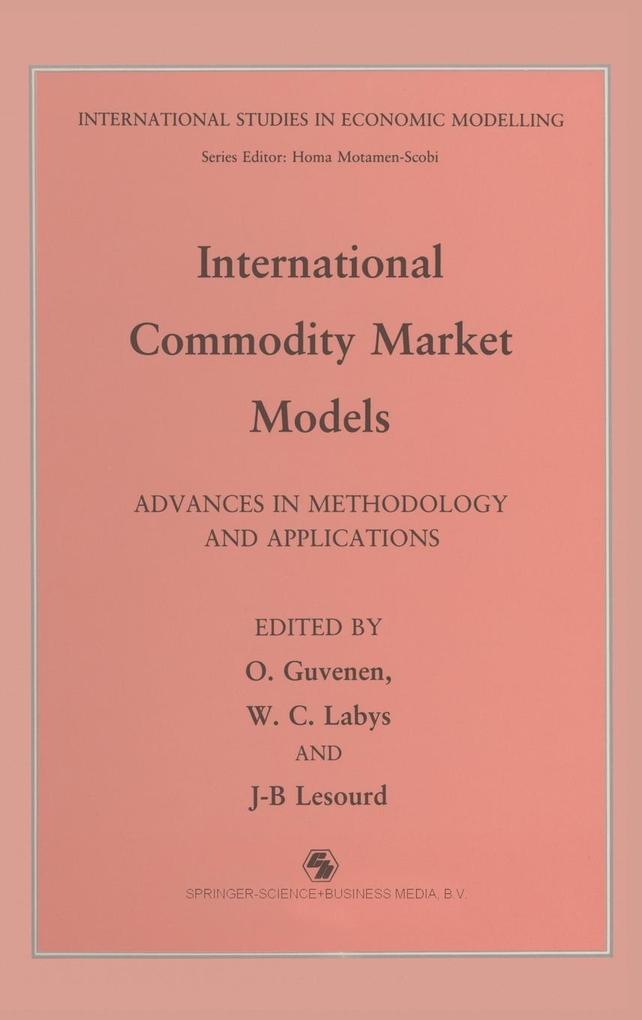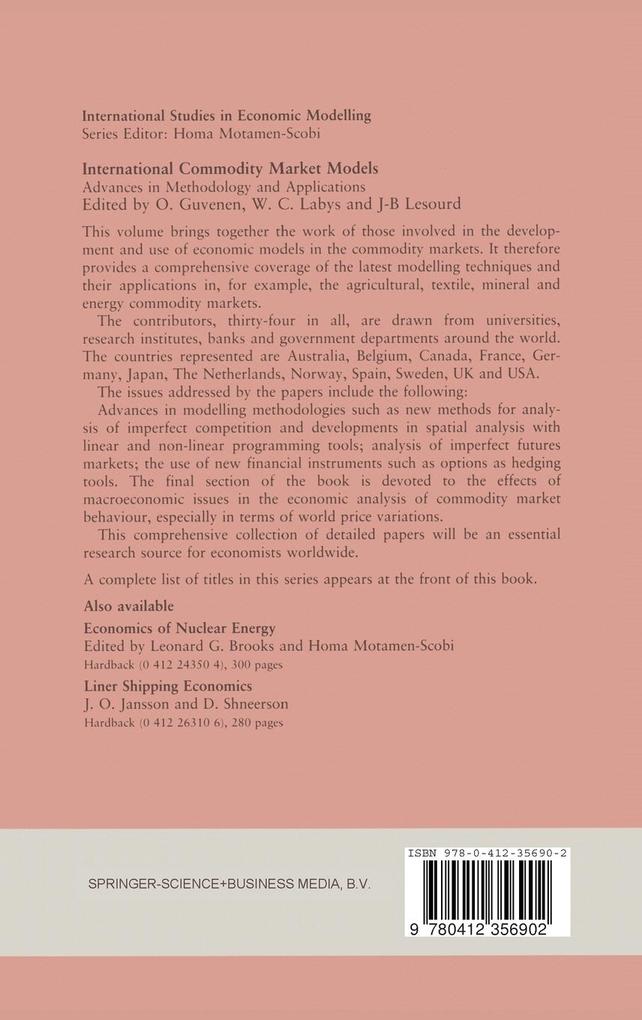
Zustellung: Mi, 04.06. - Di, 10.06.
Versand in 2 Wochen
VersandkostenfreiBestellen & in Filiale abholen:
One Advances in Modelling Methodology.- 1 New horizons in international commodity market modelling.- 2 Computing equilibria in imperfectly competitive commodity markets.- 3 Recent developments in spatial (temporal) equilibrium models: non-linearity, existence and other issues.- 4 Shadow pricing for natural resource goods and services, using the emergy method.- Two Application of New Methodologies to Particular Commodity Markets (Agricultural, Mineral and Energy Commodities).- 5 The effectiveness of the World Coffee Agreement: a simulation study using a quarterly model of the world coffee market.- 6 Modelling the world fibre market.- 7 Technical change, relative prices and intermaterial substitution.- 8 Spectral interpretation of stock adjustment processes in mineral markets.- 9 The linkages between the markets for petroleum products and the market for crude oil: an econometric-linear programming study.- 10 Modelling the international natural gas market: the case of the Western European natural gas market.- Three Application of New Methodologies to Commodity Futures Markets.- 11 Dynamic welfare analysis and commodity futures markets overshooting.- 12 When does the creation of a futures market destabilize spot prices?.- 13 The producer and futures markets.- 14 Futures prices and hidden stocks of refined oil products.- Four Application of New Methodologies to Other Commodity Market Issues.- 15 Post-recession commodity price formation.- 16 Trade-offs between short-run stability and long-run risk when stabilizing a commodity market.- 17 Are commodity prices leading indicators of OECD prices?.- 18 Conclusion.
Inhaltsverzeichnis
Part 1 Advances in modelling methology: new horizons in international commodity market modelling, W.C. Labys et al; computing equilibria in imperfectly competitive commodity markets, C. Kolstad and L. Mathiesen; recent developments in spatial (temporal) equilibrium models - non-linearity, existence and other issues, T. Takayama and T.C. MacAulay; shadow pricing for natural resource goods and services, using the emergy method, G. Pillet. Part 2 Application of new methodologies to particular commodity markets (agricultural, mineral, and energy commodities): the effectiveness of the world coffee agreement - simulation study using a quarterly model of the world coffee market, F.C. Palm and B. Vogelvang; modelling the world fibre market, M.E. Thigpen and D.O. Mitchell; technical change, relative prices anf intermaterial substitution, T.J. Considine; spectral interpretation of stock adjustment processes in mineral markets, A. Afriasabi, M. Moallem and W.C. Labys; the linkages between the markets for petroleum products and the market for crude oil - an economic linear programming study, F.G. Adams, E.A. Kroch and Z.V. Didziulis; modelling the international natural gas market - the case of the Western European natural gas market, J. Percebois, J.B. Lesourd and J.M. Ruiz. Part 3 Application of new methodologies to commodity future markets: dynamic welfare analysis and commodity futures markets overshooting, G.C. Rausser and N. Walraven; when does the creation of a futures market destabilize the spot prices?, P. Artus; the producer and futures markets, J.P. Daloz; futures prices and hidden stocks of refined oil products, M.N. Lowry. Part 4 Application of new methodologies to other commodity market issues: post-recession commodity price formation, M.J. Lord; tradeoffs between short-run stability and long-run risk when stabilizing a commodity market, B.L. Dixon and A.J. Hughes Hallett; are commodity prices leading indicators of OECD prices?, M. Durand and S. Blondal; conclusion, O. Guvenen, W.C. Labys and J.B. Lesourd.
Produktdetails
Erscheinungsdatum
31. Dezember 1990
Sprache
englisch
Seitenanzahl
356
Reihe
International Studies in Economic Modelling
Herausgegeben von
O. Güvenen, Walter C. Labys, J. B. Lesourd, O. G]venen, O. Guvenen
Verlag/Hersteller
Produktart
gebunden
Abbildungen
XXII, 330 p.
Gewicht
699 g
Größe (L/B/H)
241/160/25 mm
ISBN
9780412356902
Pressestimmen
`... reflects the new concerns of economists, mineral-commodity modellers, and industry-commodity specialists ... useful for focusing our attention on this important subject.'
Resources Policy
Resources Policy
Bewertungen
0 Bewertungen
Es wurden noch keine Bewertungen abgegeben. Schreiben Sie die erste Bewertung zu "International Commodity Market Models" und helfen Sie damit anderen bei der Kaufentscheidung.











